Crisis Situations: CHCCCS019 Recognise and Respond Assignment
VerifiedAdded on 2023/01/10
|14
|2117
|94
Homework Assignment
AI Summary
This document provides a detailed solution to a CHCCCS019 assignment, focusing on recognising and responding to crisis situations. It covers various aspects of crisis intervention, including defining crisis, identifying indicators, addressing safety concerns, and providing support. The assignment includes activities and major assessments that delve into topics such as empathic listening, risk management, legal and ethical considerations, and seeking advice. It also explores empowerment, barriers to seeking help, and documentation strategies. The solution addresses questions related to delivering lectures, managing cases, and minimizing risks. The assignment aligns with the six key principles of adult safeguarding, emphasizing empowerment, prevention, proportionality, protection, partnership, and accountability. The content offers insights into managing workplace hazards, natural disasters, and emergencies involving violence, terrorism, and mental health issues. Overall, the assignment aims to equip community services workers with the knowledge and skills to effectively intervene in crisis situations.

90008
Unit Code CHCCCS019 Unit Name and
release number
Recognise and respond to crisis
situations
Unit Descriptor
This unit describes the skills and knowledge required to recognise situations
where people may be in imminent crisis, and then to work collaboratively to
minimise any safety concerns and make plans to access required support
services.
This unit applies to any community services worker involved in crisis
intervention. Management of the crisis may involve face-to-face, telephone
or remote contact with persons involved.
Pre-requisites Not Applicable
What do I need
to do to be
deemed
competent?
To be deemed competent in this unit you must be able to provide evidence
that you can:
Elements define the essential outcomes of the unit
1. Identify imminent crisis situations
2. Address immediate safety concerns
3. Provide referral for crisis intervention support
4. Care for self
Unit of Competence at
https://training.gov.au/Training/Details/CHCCCS019
To achieve a
satisfactory
result
The Assessor will assess competence against the performance criteria,
knowledge and skills plus foundation skills as specified in the ‘Unit of
Competency” details of the unit listed above.
This unit is ungraded. Your final result will be recorded as competency
achieved (AC) or competency not achieved (NC)
You will be given an outline of assessment tasks and due dates for each
assessment event.
Each assessment task/event will be marked as Satisfactory or Unsatisfactory.
You must gain a satisfactory result for each assessment task/event to achieve
a result of AC (Competency Achieved) for this unit of competence.
Written Assessment Task v1 Last Updated: 4 May 2017 Page 1 of 14
Unit Code CHCCCS019 Unit Name and
release number
Recognise and respond to crisis
situations
Unit Descriptor
This unit describes the skills and knowledge required to recognise situations
where people may be in imminent crisis, and then to work collaboratively to
minimise any safety concerns and make plans to access required support
services.
This unit applies to any community services worker involved in crisis
intervention. Management of the crisis may involve face-to-face, telephone
or remote contact with persons involved.
Pre-requisites Not Applicable
What do I need
to do to be
deemed
competent?
To be deemed competent in this unit you must be able to provide evidence
that you can:
Elements define the essential outcomes of the unit
1. Identify imminent crisis situations
2. Address immediate safety concerns
3. Provide referral for crisis intervention support
4. Care for self
Unit of Competence at
https://training.gov.au/Training/Details/CHCCCS019
To achieve a
satisfactory
result
The Assessor will assess competence against the performance criteria,
knowledge and skills plus foundation skills as specified in the ‘Unit of
Competency” details of the unit listed above.
This unit is ungraded. Your final result will be recorded as competency
achieved (AC) or competency not achieved (NC)
You will be given an outline of assessment tasks and due dates for each
assessment event.
Each assessment task/event will be marked as Satisfactory or Unsatisfactory.
You must gain a satisfactory result for each assessment task/event to achieve
a result of AC (Competency Achieved) for this unit of competence.
Written Assessment Task v1 Last Updated: 4 May 2017 Page 1 of 14
Paraphrase This Document
Need a fresh take? Get an instant paraphrase of this document with our AI Paraphraser
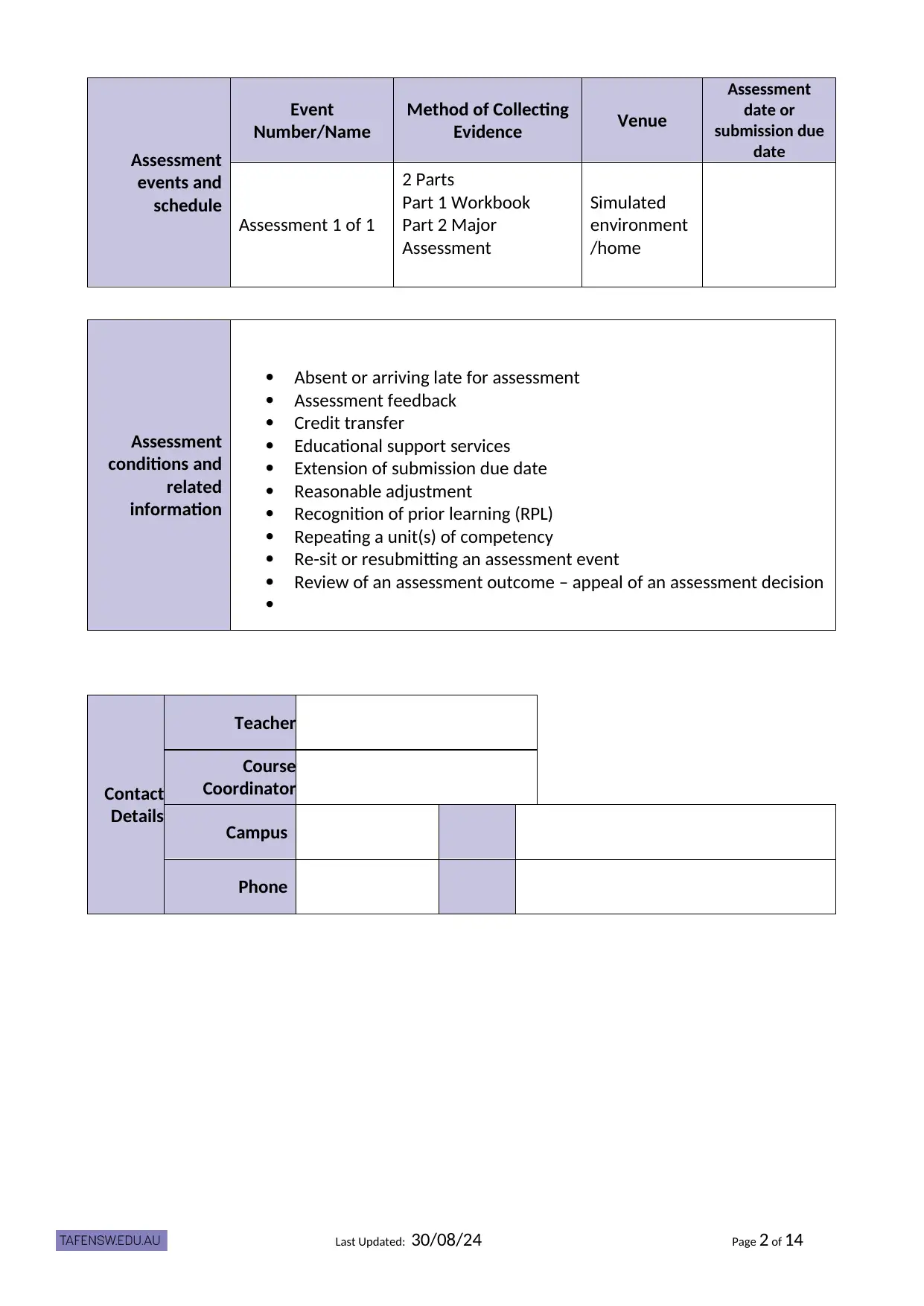
Assessment
events and
schedule
Event
Number/Name
Method of Collecting
Evidence Venue
Assessment
date or
submission due
date
Assessment 1 of 1
2 Parts
Part 1 Workbook
Part 2 Major
Assessment
Simulated
environment
/home
Assessment
conditions and
related
information
Absent or arriving late for assessment
Assessment feedback
Credit transfer
Educational support services
Extension of submission due date
Reasonable adjustment
Recognition of prior learning (RPL)
Repeating a unit(s) of competency
Re-sit or resubmitting an assessment event
Review of an assessment outcome – appeal of an assessment decision
Contact
Details
Teacher
Course
Coordinator
Campus
Phone
Last Updated: 30/08/24 Page 2 of 14
events and
schedule
Event
Number/Name
Method of Collecting
Evidence Venue
Assessment
date or
submission due
date
Assessment 1 of 1
2 Parts
Part 1 Workbook
Part 2 Major
Assessment
Simulated
environment
/home
Assessment
conditions and
related
information
Absent or arriving late for assessment
Assessment feedback
Credit transfer
Educational support services
Extension of submission due date
Reasonable adjustment
Recognition of prior learning (RPL)
Repeating a unit(s) of competency
Re-sit or resubmitting an assessment event
Review of an assessment outcome – appeal of an assessment decision
Contact
Details
Teacher
Course
Coordinator
Campus
Phone
Last Updated: 30/08/24 Page 2 of 14

Last Updated: 30/08/24 Page 3 of 14
⊘ This is a preview!⊘
Do you want full access?
Subscribe today to unlock all pages.

Trusted by 1+ million students worldwide
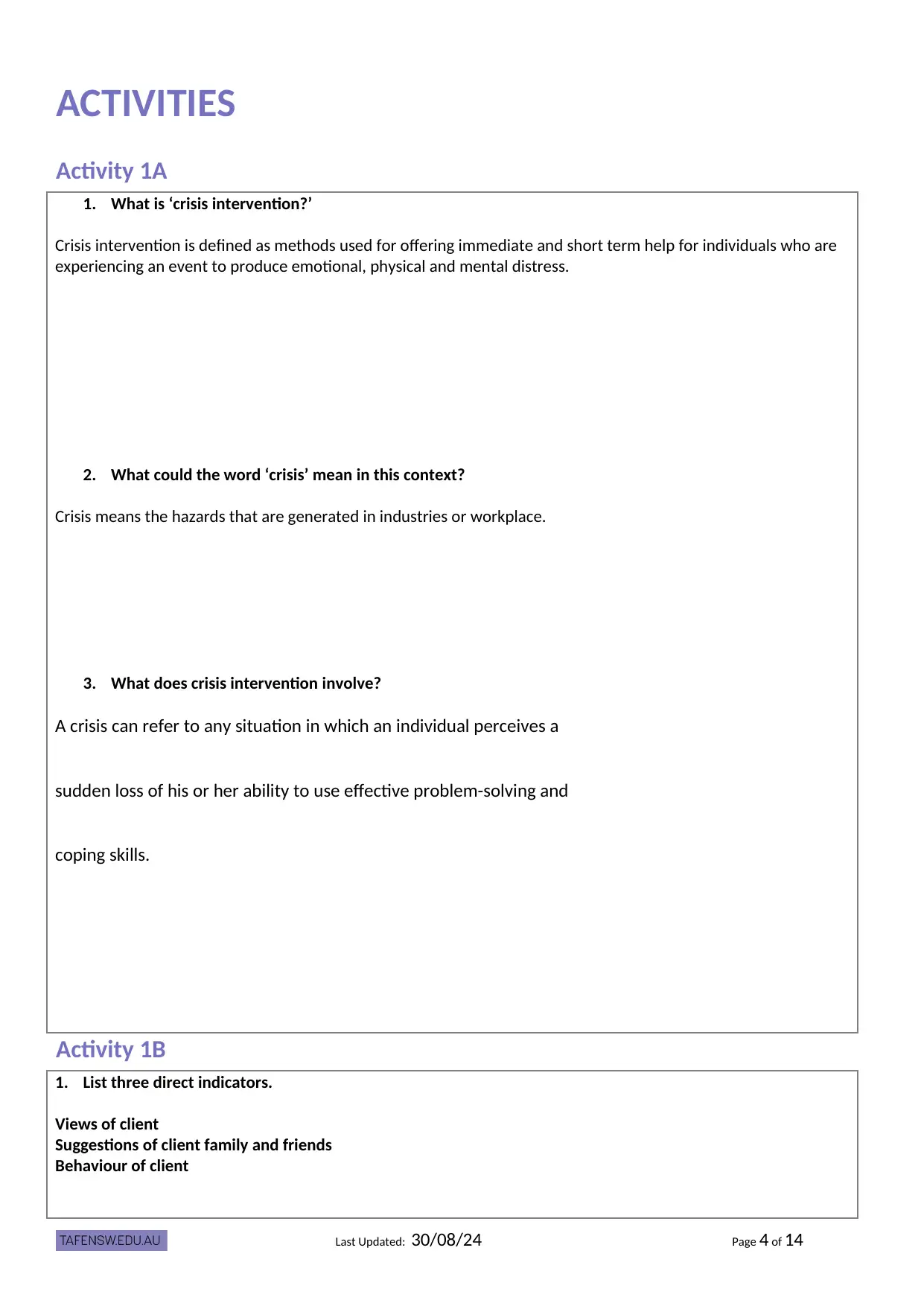
ACTIVITIES
Activity 1A
1. What is ‘crisis intervention?’
Crisis intervention is defined as methods used for offering immediate and short term help for individuals who are
experiencing an event to produce emotional, physical and mental distress.
2. What could the word ‘crisis’ mean in this context?
Crisis means the hazards that are generated in industries or workplace.
3. What does crisis intervention involve?
A crisis can refer to any situation in which an individual perceives a
sudden loss of his or her ability to use effective problem-solving and
coping skills.
Activity 1B
1. List three direct indicators.
Views of client
Suggestions of client family and friends
Behaviour of client
Last Updated: 30/08/24 Page 4 of 14
Activity 1A
1. What is ‘crisis intervention?’
Crisis intervention is defined as methods used for offering immediate and short term help for individuals who are
experiencing an event to produce emotional, physical and mental distress.
2. What could the word ‘crisis’ mean in this context?
Crisis means the hazards that are generated in industries or workplace.
3. What does crisis intervention involve?
A crisis can refer to any situation in which an individual perceives a
sudden loss of his or her ability to use effective problem-solving and
coping skills.
Activity 1B
1. List three direct indicators.
Views of client
Suggestions of client family and friends
Behaviour of client
Last Updated: 30/08/24 Page 4 of 14
Paraphrase This Document
Need a fresh take? Get an instant paraphrase of this document with our AI Paraphraser
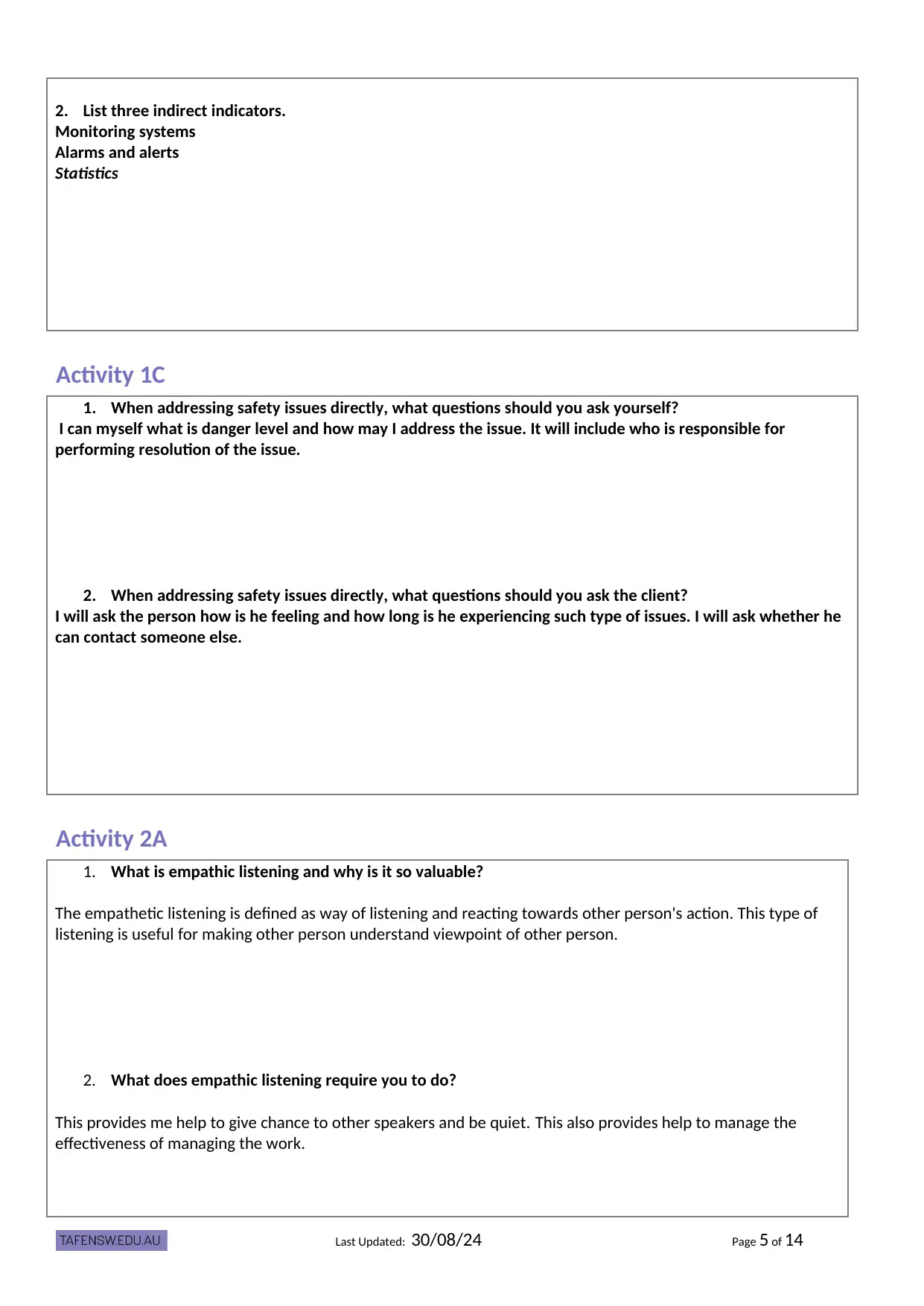
2. List three indirect indicators.
Monitoring systems
Alarms and alerts
Statistics
Activity 1C
1. When addressing safety issues directly, what questions should you ask yourself?
I can myself what is danger level and how may I address the issue. It will include who is responsible for
performing resolution of the issue.
2. When addressing safety issues directly, what questions should you ask the client?
I will ask the person how is he feeling and how long is he experiencing such type of issues. I will ask whether he
can contact someone else.
Activity 2A
1. What is empathic listening and why is it so valuable?
The empathetic listening is defined as way of listening and reacting towards other person's action. This type of
listening is useful for making other person understand viewpoint of other person.
2. What does empathic listening require you to do?
This provides me help to give chance to other speakers and be quiet. This also provides help to manage the
effectiveness of managing the work.
Last Updated: 30/08/24 Page 5 of 14
Monitoring systems
Alarms and alerts
Statistics
Activity 1C
1. When addressing safety issues directly, what questions should you ask yourself?
I can myself what is danger level and how may I address the issue. It will include who is responsible for
performing resolution of the issue.
2. When addressing safety issues directly, what questions should you ask the client?
I will ask the person how is he feeling and how long is he experiencing such type of issues. I will ask whether he
can contact someone else.
Activity 2A
1. What is empathic listening and why is it so valuable?
The empathetic listening is defined as way of listening and reacting towards other person's action. This type of
listening is useful for making other person understand viewpoint of other person.
2. What does empathic listening require you to do?
This provides me help to give chance to other speakers and be quiet. This also provides help to manage the
effectiveness of managing the work.
Last Updated: 30/08/24 Page 5 of 14

3. List five ways of being mindful during crisis intervention.
Avoidance of imposing ones values on others
By adopting organization’s values
Being mindful of behaviour at workplace
Keeping political, religious and spiritual beliefs to oneself
De constructing assumptions about who may be at risk
Activity 2B
1. When affirming and strengthening links to safety and living, what should you stress the importance of?
To increase the strengthening links to safety and living, three points should be kept in mind. First is that be
positive about the situations in life, tolerant to unlikely things and ignore toxic habits.
Activity 2C
1. In times of crisis, what helps people to react reliably?
The most important thing that helps a person to react reliably is the positivity in the surroundings and stable
thinking and analytical ability. Focal point is stable mental health.
Last Updated: 30/08/24 Page 6 of 14
Avoidance of imposing ones values on others
By adopting organization’s values
Being mindful of behaviour at workplace
Keeping political, religious and spiritual beliefs to oneself
De constructing assumptions about who may be at risk
Activity 2B
1. When affirming and strengthening links to safety and living, what should you stress the importance of?
To increase the strengthening links to safety and living, three points should be kept in mind. First is that be
positive about the situations in life, tolerant to unlikely things and ignore toxic habits.
Activity 2C
1. In times of crisis, what helps people to react reliably?
The most important thing that helps a person to react reliably is the positivity in the surroundings and stable
thinking and analytical ability. Focal point is stable mental health.
Last Updated: 30/08/24 Page 6 of 14
⊘ This is a preview!⊘
Do you want full access?
Subscribe today to unlock all pages.

Trusted by 1+ million students worldwide
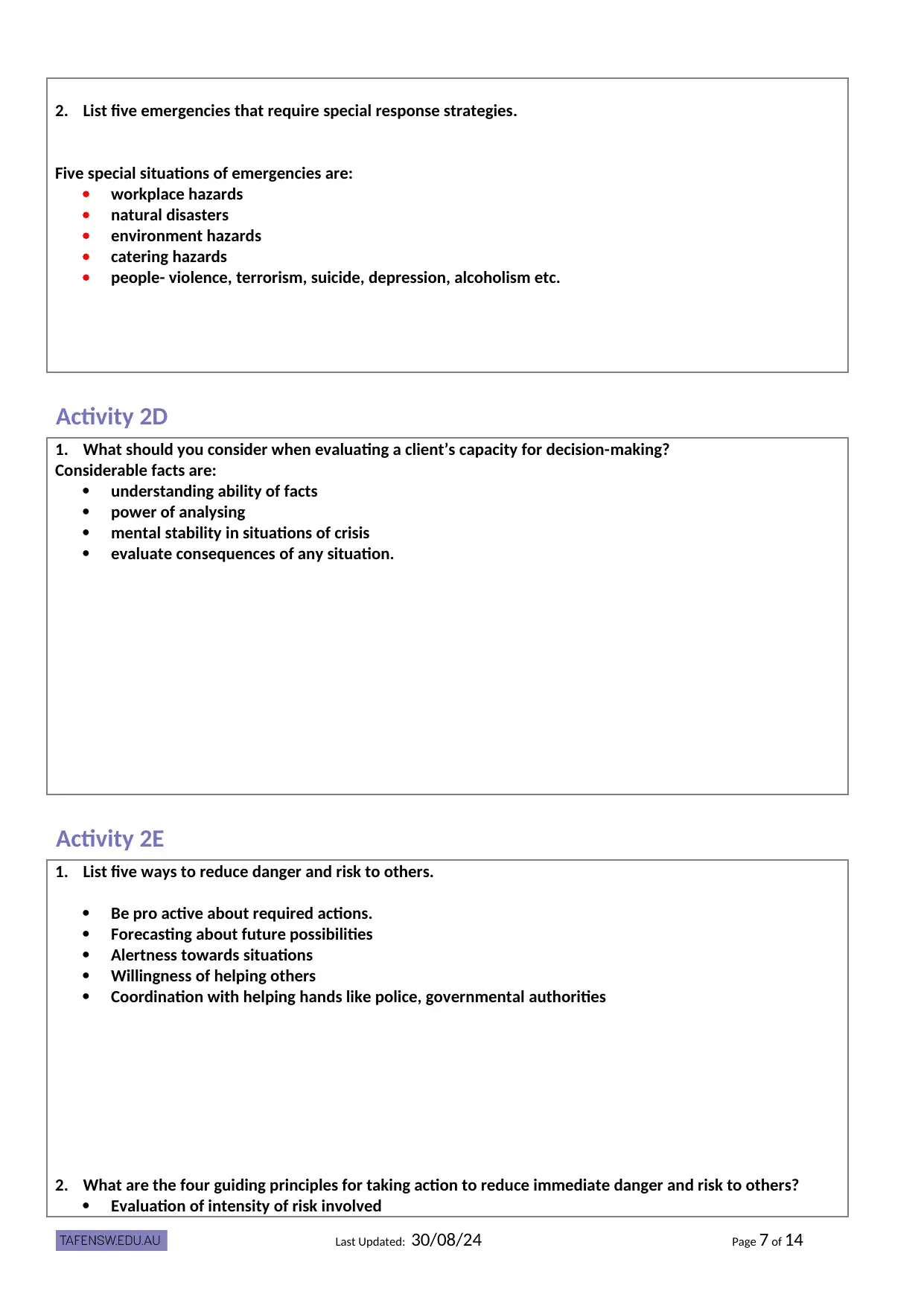
2. List five emergencies that require special response strategies.
Five special situations of emergencies are:
workplace hazards
natural disasters
environment hazards
catering hazards
people- violence, terrorism, suicide, depression, alcoholism etc.
Activity 2D
1. What should you consider when evaluating a client’s capacity for decision-making?
Considerable facts are:
understanding ability of facts
power of analysing
mental stability in situations of crisis
evaluate consequences of any situation.
Activity 2E
1. List five ways to reduce danger and risk to others.
Be pro active about required actions.
Forecasting about future possibilities
Alertness towards situations
Willingness of helping others
Coordination with helping hands like police, governmental authorities
2. What are the four guiding principles for taking action to reduce immediate danger and risk to others?
Evaluation of intensity of risk involved
Last Updated: 30/08/24 Page 7 of 14
Five special situations of emergencies are:
workplace hazards
natural disasters
environment hazards
catering hazards
people- violence, terrorism, suicide, depression, alcoholism etc.
Activity 2D
1. What should you consider when evaluating a client’s capacity for decision-making?
Considerable facts are:
understanding ability of facts
power of analysing
mental stability in situations of crisis
evaluate consequences of any situation.
Activity 2E
1. List five ways to reduce danger and risk to others.
Be pro active about required actions.
Forecasting about future possibilities
Alertness towards situations
Willingness of helping others
Coordination with helping hands like police, governmental authorities
2. What are the four guiding principles for taking action to reduce immediate danger and risk to others?
Evaluation of intensity of risk involved
Last Updated: 30/08/24 Page 7 of 14
Paraphrase This Document
Need a fresh take? Get an instant paraphrase of this document with our AI Paraphraser
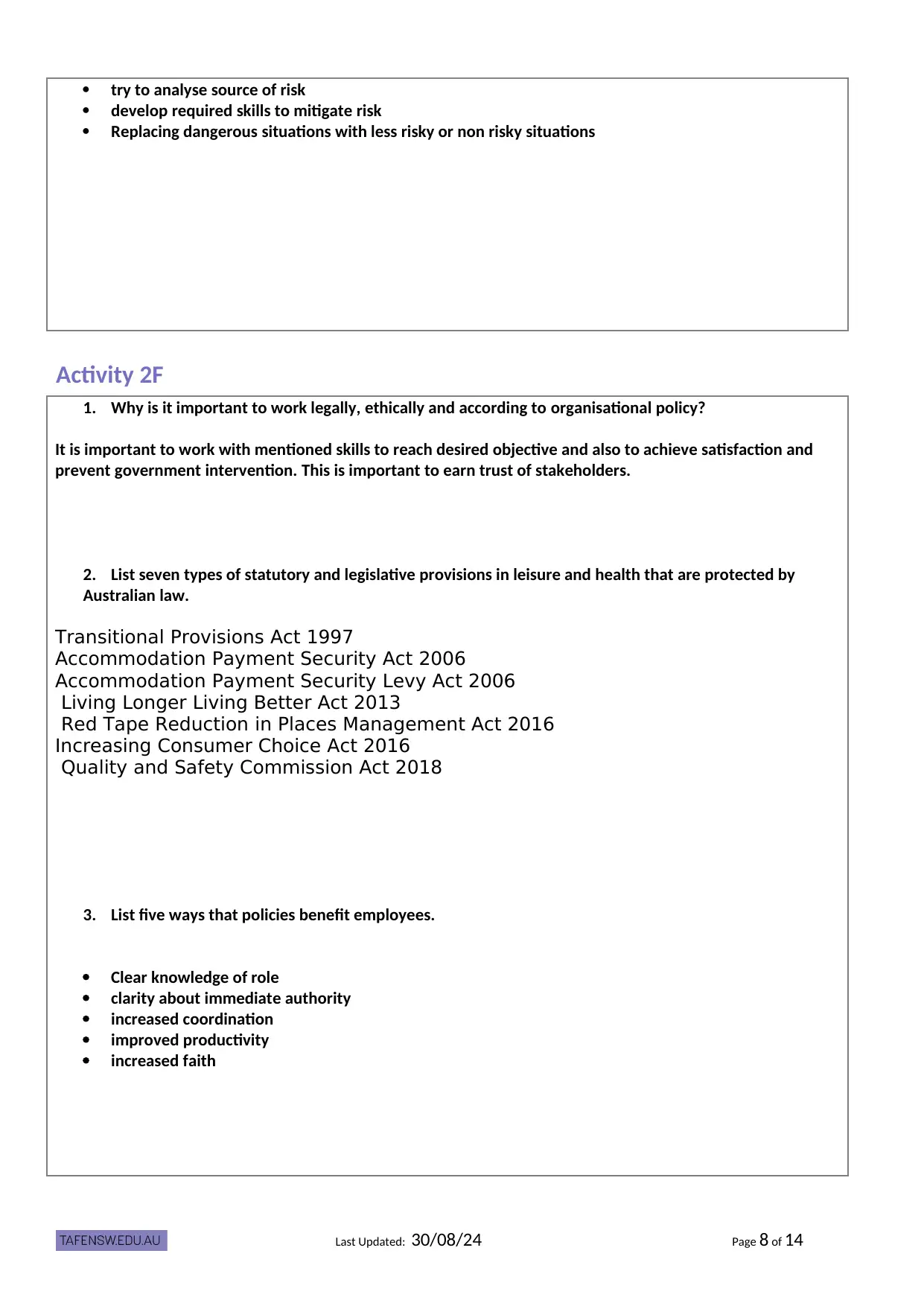
try to analyse source of risk
develop required skills to mitigate risk
Replacing dangerous situations with less risky or non risky situations
Activity 2F
1. Why is it important to work legally, ethically and according to organisational policy?
It is important to work with mentioned skills to reach desired objective and also to achieve satisfaction and
prevent government intervention. This is important to earn trust of stakeholders.
2. List seven types of statutory and legislative provisions in leisure and health that are protected by
Australian law.
Transitional Provisions Act 1997
Accommodation Payment Security Act 2006
Accommodation Payment Security Levy Act 2006
Living Longer Living Better Act 2013
Red Tape Reduction in Places Management Act 2016
Increasing Consumer Choice Act 2016
Quality and Safety Commission Act 2018
3. List five ways that policies benefit employees.
Clear knowledge of role
clarity about immediate authority
increased coordination
improved productivity
increased faith
Last Updated: 30/08/24 Page 8 of 14
develop required skills to mitigate risk
Replacing dangerous situations with less risky or non risky situations
Activity 2F
1. Why is it important to work legally, ethically and according to organisational policy?
It is important to work with mentioned skills to reach desired objective and also to achieve satisfaction and
prevent government intervention. This is important to earn trust of stakeholders.
2. List seven types of statutory and legislative provisions in leisure and health that are protected by
Australian law.
Transitional Provisions Act 1997
Accommodation Payment Security Act 2006
Accommodation Payment Security Levy Act 2006
Living Longer Living Better Act 2013
Red Tape Reduction in Places Management Act 2016
Increasing Consumer Choice Act 2016
Quality and Safety Commission Act 2018
3. List five ways that policies benefit employees.
Clear knowledge of role
clarity about immediate authority
increased coordination
improved productivity
increased faith
Last Updated: 30/08/24 Page 8 of 14

Activity 2G
1. List five benefits of seeking advice or assistance from a supervisor.
Experienced advice
improved communication
job satisfaction
managed workload
improved productivity
2. When seeking advice, what should you outline?
The actual problem with the required clear advice should be outlined, so that, there is no barriers in
communication.
Activity 3A
1. Describe the process of empowerment.
This is defined as process which provides greater autonomy to staff and employees by sharing authentic and
appropriate information.
2. What does empowerment involve?
This involve removing conditions that cause powerlessness and enhancing the employee feelings of self
efficacy.
Last Updated: 30/08/24 Page 9 of 14
1. List five benefits of seeking advice or assistance from a supervisor.
Experienced advice
improved communication
job satisfaction
managed workload
improved productivity
2. When seeking advice, what should you outline?
The actual problem with the required clear advice should be outlined, so that, there is no barriers in
communication.
Activity 3A
1. Describe the process of empowerment.
This is defined as process which provides greater autonomy to staff and employees by sharing authentic and
appropriate information.
2. What does empowerment involve?
This involve removing conditions that cause powerlessness and enhancing the employee feelings of self
efficacy.
Last Updated: 30/08/24 Page 9 of 14
⊘ This is a preview!⊘
Do you want full access?
Subscribe today to unlock all pages.

Trusted by 1+ million students worldwide
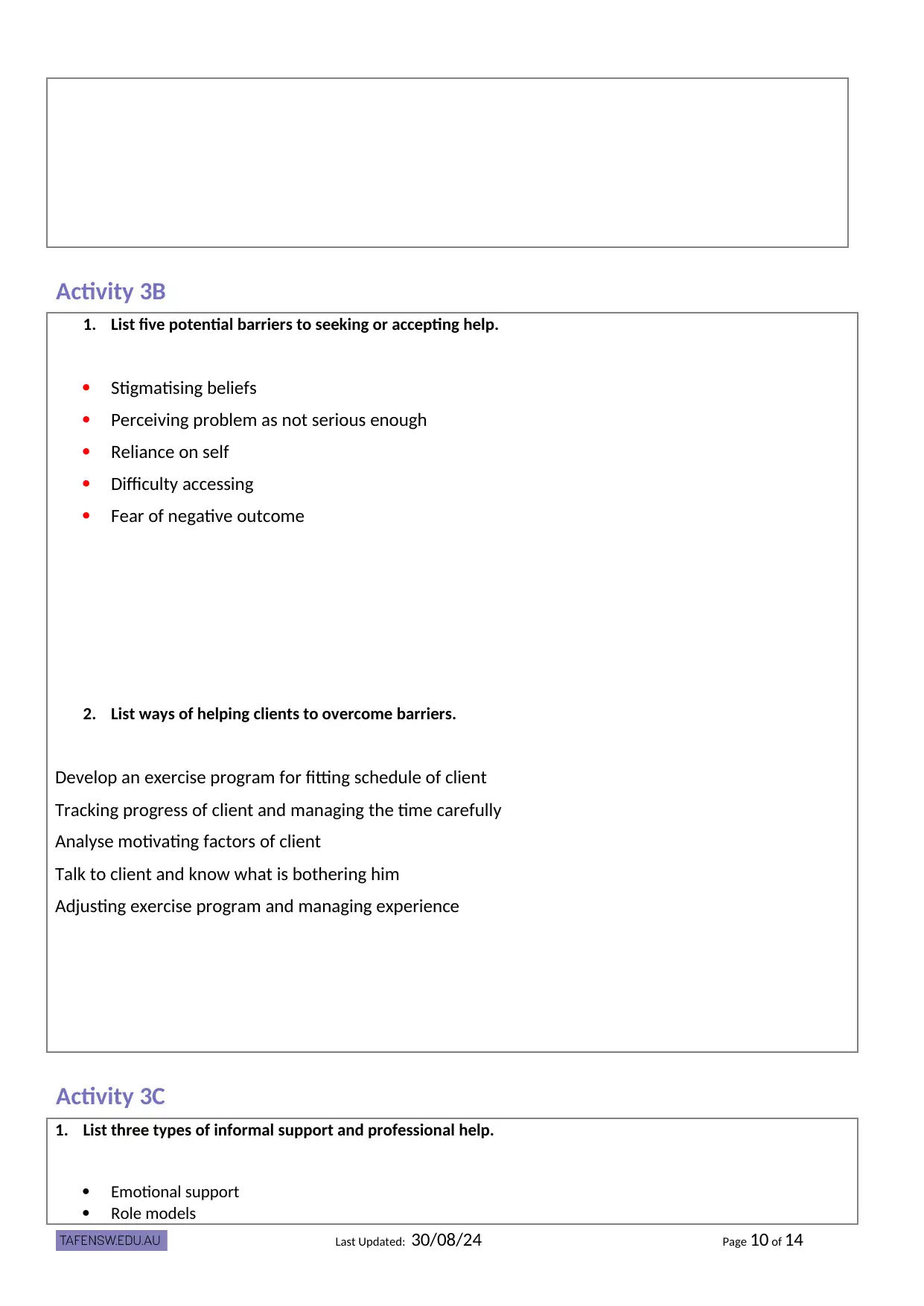
Activity 3B
1. List five potential barriers to seeking or accepting help.
Stigmatising beliefs
Perceiving problem as not serious enough
Reliance on self
Difficulty accessing
Fear of negative outcome
2. List ways of helping clients to overcome barriers.
Develop an exercise program for fitting schedule of client
Tracking progress of client and managing the time carefully
Analyse motivating factors of client
Talk to client and know what is bothering him
Adjusting exercise program and managing experience
Activity 3C
1. List three types of informal support and professional help.
Emotional support
Role models
Last Updated: 30/08/24 Page 10 of 14
1. List five potential barriers to seeking or accepting help.
Stigmatising beliefs
Perceiving problem as not serious enough
Reliance on self
Difficulty accessing
Fear of negative outcome
2. List ways of helping clients to overcome barriers.
Develop an exercise program for fitting schedule of client
Tracking progress of client and managing the time carefully
Analyse motivating factors of client
Talk to client and know what is bothering him
Adjusting exercise program and managing experience
Activity 3C
1. List three types of informal support and professional help.
Emotional support
Role models
Last Updated: 30/08/24 Page 10 of 14
Paraphrase This Document
Need a fresh take? Get an instant paraphrase of this document with our AI Paraphraser
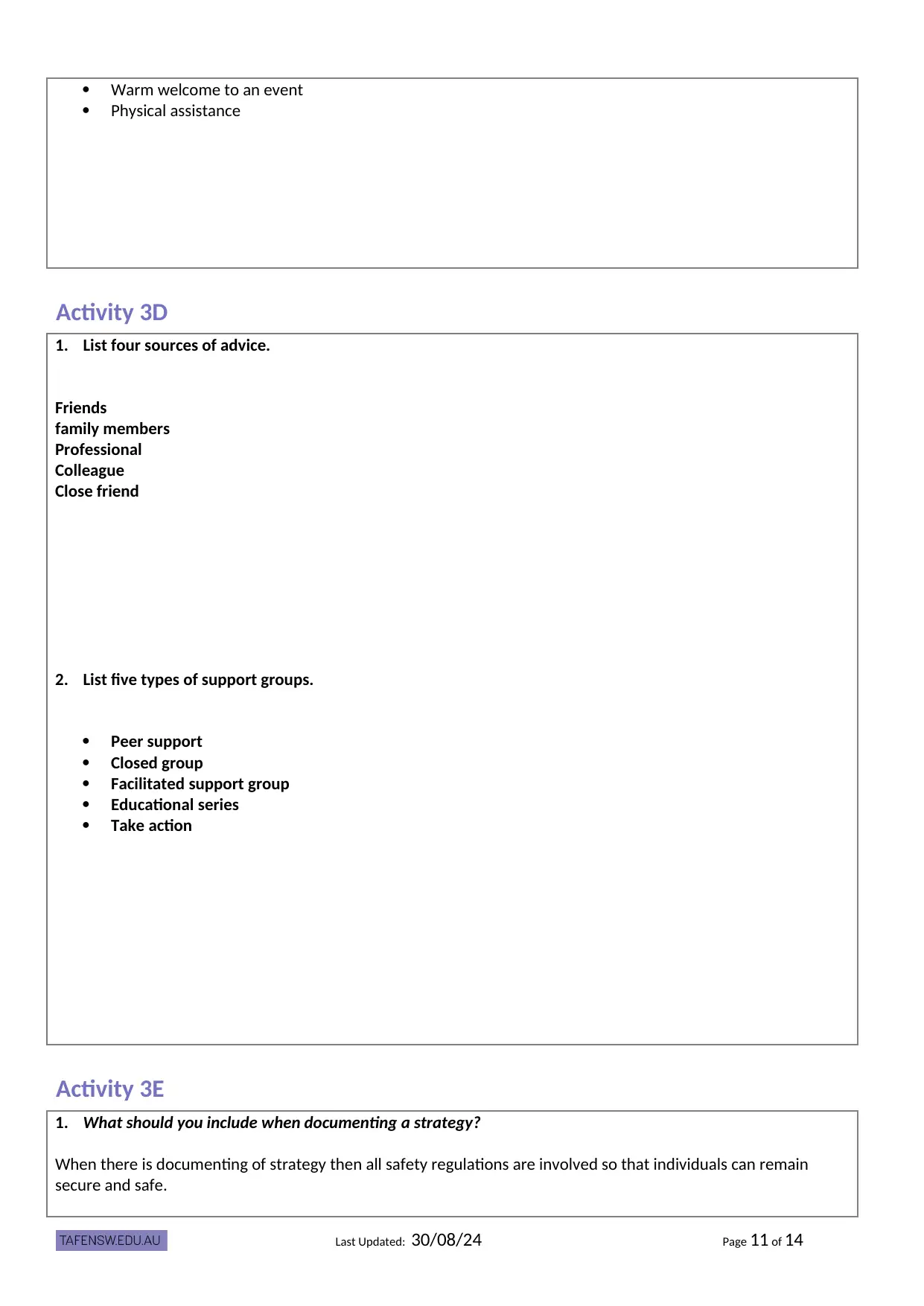
Warm welcome to an event
Physical assistance
Activity 3D
1. List four sources of advice.
Friends
family members
Professional
Colleague
Close friend
2. List five types of support groups.
Peer support
Closed group
Facilitated support group
Educational series
Take action
Activity 3E
1. What should you include when documenting a strategy?
When there is documenting of strategy then all safety regulations are involved so that individuals can remain
secure and safe.
Last Updated: 30/08/24 Page 11 of 14
Physical assistance
Activity 3D
1. List four sources of advice.
Friends
family members
Professional
Colleague
Close friend
2. List five types of support groups.
Peer support
Closed group
Facilitated support group
Educational series
Take action
Activity 3E
1. What should you include when documenting a strategy?
When there is documenting of strategy then all safety regulations are involved so that individuals can remain
secure and safe.
Last Updated: 30/08/24 Page 11 of 14
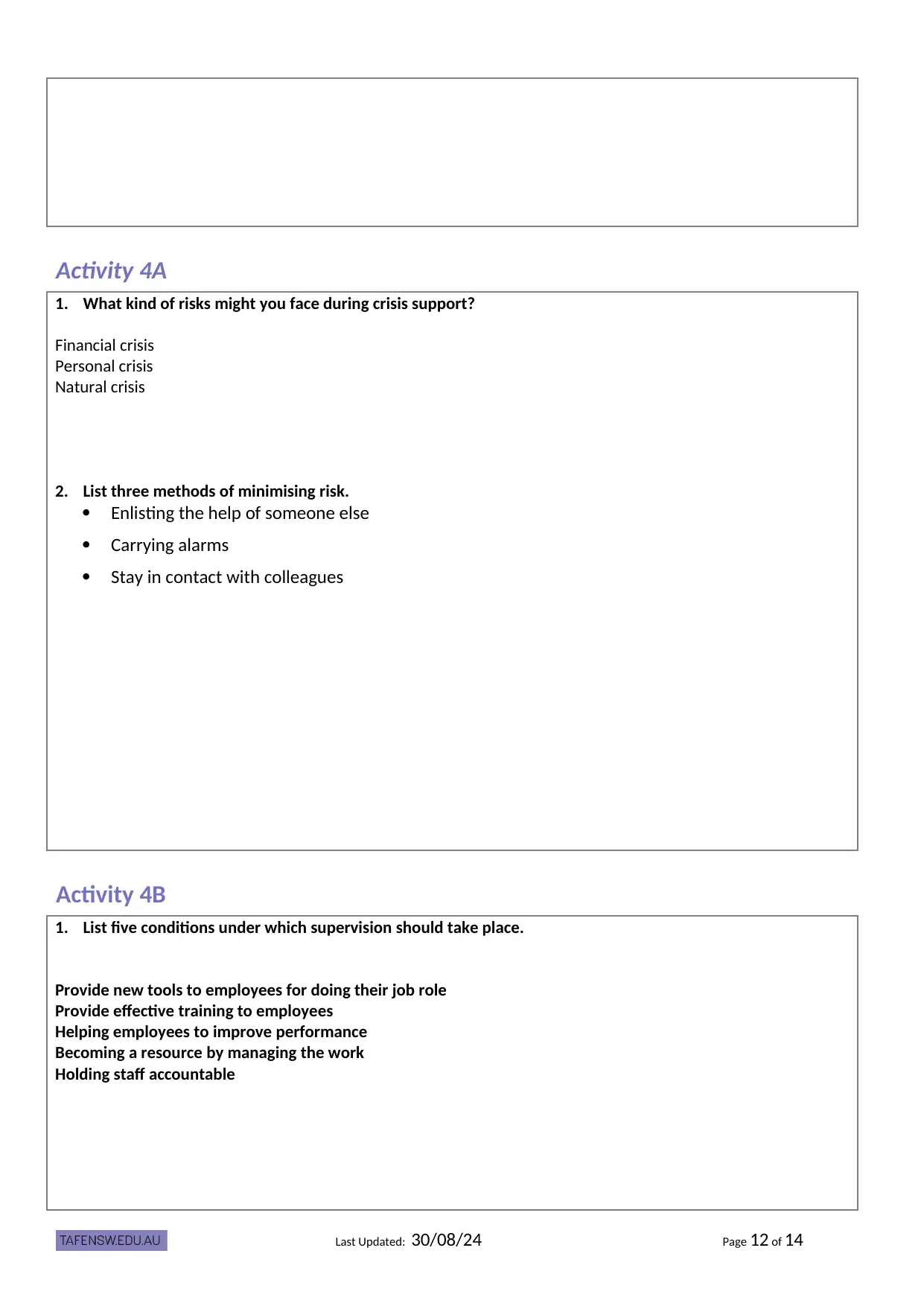
Activity 4A
1. What kind of risks might you face during crisis support?
Financial crisis
Personal crisis
Natural crisis
2. List three methods of minimising risk.
Enlisting the help of someone else
Carrying alarms
Stay in contact with colleagues
Activity 4B
1. List five conditions under which supervision should take place.
Provide new tools to employees for doing their job role
Provide effective training to employees
Helping employees to improve performance
Becoming a resource by managing the work
Holding staff accountable
Last Updated: 30/08/24 Page 12 of 14
1. What kind of risks might you face during crisis support?
Financial crisis
Personal crisis
Natural crisis
2. List three methods of minimising risk.
Enlisting the help of someone else
Carrying alarms
Stay in contact with colleagues
Activity 4B
1. List five conditions under which supervision should take place.
Provide new tools to employees for doing their job role
Provide effective training to employees
Helping employees to improve performance
Becoming a resource by managing the work
Holding staff accountable
Last Updated: 30/08/24 Page 12 of 14
⊘ This is a preview!⊘
Do you want full access?
Subscribe today to unlock all pages.

Trusted by 1+ million students worldwide
1 out of 14
Related Documents
Your All-in-One AI-Powered Toolkit for Academic Success.
+13062052269
info@desklib.com
Available 24*7 on WhatsApp / Email
![[object Object]](/_next/static/media/star-bottom.7253800d.svg)
Unlock your academic potential
Copyright © 2020–2025 A2Z Services. All Rights Reserved. Developed and managed by ZUCOL.





